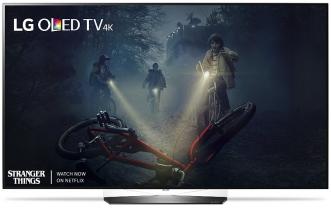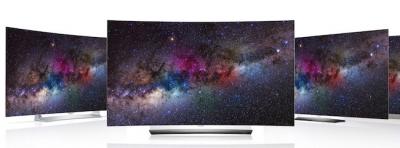Two major display technologies are used today to create high-end premium TVs, OLEDs and QLEDs. This article aims to compare these two technologies and detail the market status of both the premium TV market.
While OLED is a next-generation display technology that uses organic materials that emit light when electricity is applied, QLED TVs are still LED-backlit LCD TVs, but ones enhanced with quantum-dots materials. QLED TVs also called QDLED (or QD-LED) TVs and QD TVs. Reviews of OLED TVs are terrific, and most experts and consumers agree that these OLED TVs are the best TVs ever produced - with virtually perfect image quality and beautiful form factors.

An OLED TV vs an QLED TV
An OLED (Organic Light Emitting Diodes) panel is made from organic (carbon-based) materials that emit light when electricity is applied. An OLED TV is made from millions of pixels, each made from red, green and blue tiny OLED materials. Or at least that's the theory, all current OLED TV panels are made by LG which is using a slightly different architecture - white OLED pixels with color filters on top.
A QLED TV is a confusing term - as it should actually be called LED-backlit LCD enhanced with Quantum Dots (QD) materials. This is still LCD technology, which uses LEDs as the backlight source (instead of the fluorescent tubes used in older LCDs) and liquid crystals and color filters to control and modulate the light. In regular LCDs the backlight is white - but in QLEDs the backlight emits blue light which is converted to white by the quantum dots coating.

OLED displays have the following advantages over LCD displays:
- As OLEDs are self-emissive, the contrast ratio is much better in an OLED (true blacks). OLEDs also feature much faster refresh rates and wider viewing angels.
- OLEDs typically consume less power (as only lit pixels draw power) - although this depends on the images viewed
- Next-gen designs: OLEDs are thinner and lighter than LCD panels. OLEDs can be made flexible, and companies are developing bendable, rollable and transparent OLED TVs.
OLED technology is not perfect, though, and QLED TVs have some advantages as well:
- First and most important, QLED TVs can be made at a lower cost compared to OLEDs. This is the situation today - although in the future it is expected that OLEDs will be more cost effective than LCDs (especially as production volume increases)
- One of the advantages of the QD conversion is that the color light output is purer, and so the TVs can offer a wide color gamut. Currently QDLEDs offer a higher color gamut compared to OLEDs, although this will likely change in the future
- A major disadvantage of OLED panels is burn-in and image retention. As each pixel degrades differently according to its use, this could be a real issue.
What about emissive quantum dots TVs?
Current QLED TVs use the photo-luminescence qualities of quantum dots - the fact that they can absorb light at a certain wavelength and emit a light at a different wavelength (specifically convert blue light to white). In a similar fashion to OLED materials, QDs also feature electro-luminescence, which means that light is emitted when electricity is applied.
This means that in the future QDs could be used to create true emissive displays, one that do not require color filters and liquid crystal to module the light. These kinds of displays are already in development and the hope is that true QD-LED TVs will feature the image quality of OLED displays but at an even higher efficiency.
Samsung's QD-OLED TVs
Another type of TV worth mentioning is Samsung's QD-OLED, which are based on blue OLED emitters and QD materials for color conversion. In 2019 Samsung Display announced its decision to invest $10.85 billion in QD-OLED TV R&D and production lines. A few years later, SDC started to produce panels in its first fab, mass producing TV and monitor QD-OLEDs.
Samsung attracted several customers (Sony and Samsung Electronics for TV panels, and several companies for its monitors), and these displays have been very well received by the market. Samsung is currently producing around a million QD-OLED panels per year. The future roadmap of Samsung's QD-OLED displays is not clear.

